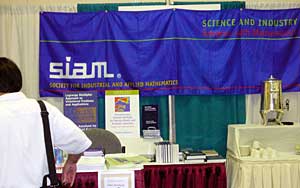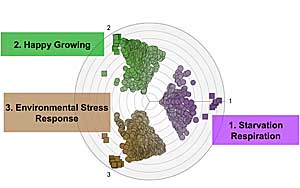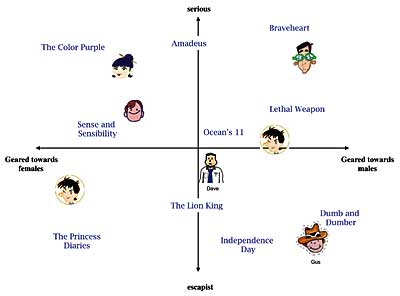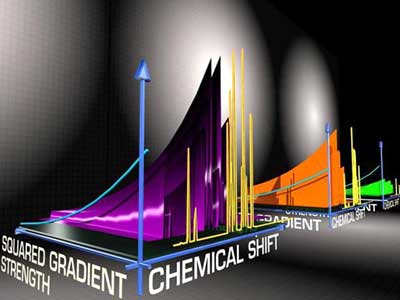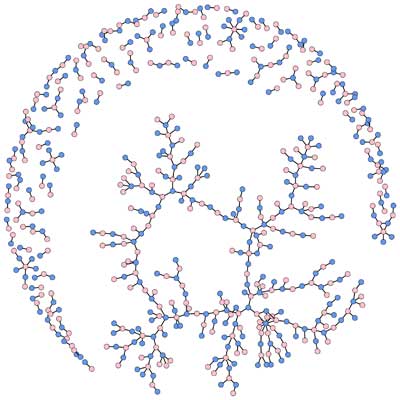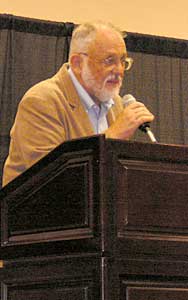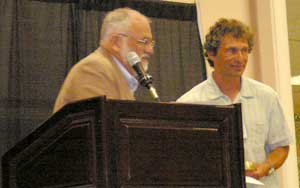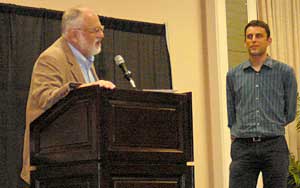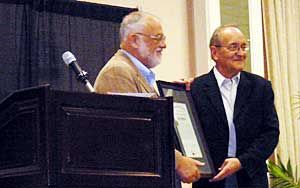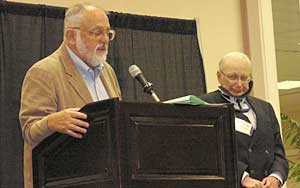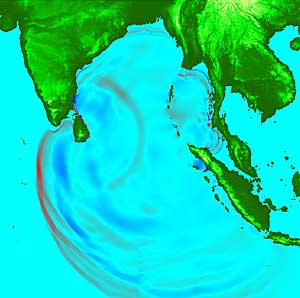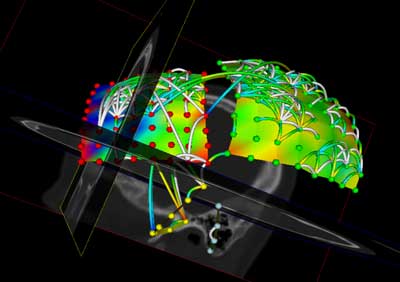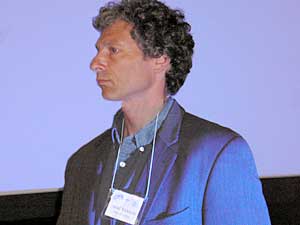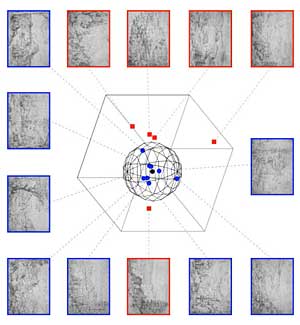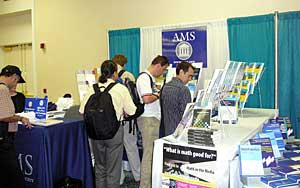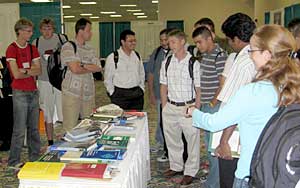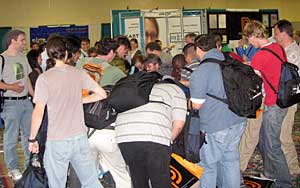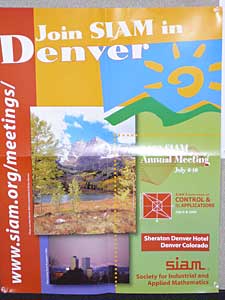
The 2008 SIAM Annual Meeting
The 2008 annual meeting of the Society for Industrial and Applied Mathematics (SIAM) drew a record number of attendees, approximately 1200, to the Town and Country Resort in San Diego, CA July 7-11. Below are links to summaries of some of the events that took place at the meeting.
* Beyond the Human Genome Project * AWM-SIAM Sonia Kovalevsky Lecture * The Netflix Prize * Tensor Decompositions in Chemistry * Complex Networks * Prizes and Awards Luncheon * Geophysical Flows * Python and Sage * Whydomath * I.E. Block Community Lecture * Social Networks * Exhibits
Beyond the Human Genome Project: Challenges and Opportunities in Genomic Medicine, Jill P. Mesirov, Broad Institute of MIT and Harvard University
|
Mesirov described recent discoveries that have come about as a result of mathematical analysis, usually involving a vast amount of biological data. Graph theory, matching algorithms, and statistics all played a part in mapping the human genome, but much work still remains. The medical community hopes for an understanding of disease at the molecular level, perhaps leading to treatments customized to the individual patient. Some diseases, such as sickle cell anemia and cystic fibrosis, can be traced to a single gene, but most diseases are more complex, involving combinations of gene variants. Mesirov cited three diseases for which researchers hope to use gene mapping to differentiate between either the type of disease or the type of person, in order to determine the best treatment. Genetic chips successfully showed the difference between two types of leukemia, and thus determined the proper treatment. A study of a type of brain cancer was not as successful, as no genetic markers were found to differentiate between people who would respond to treatment and those who would not. Mesirov is now working on a study of malaria to separate those who have the parasite but do not have any symptoms, from those who get sick or die once infected. She recently did an analysis of parasitic cells from people in Senegal (most studies use cells grown in the lab) and found two clusters of malarial cells exhibiting behavior that hadn't been seen in previous studies. These clusters of malarial cells correspond to well-known behaviors of yeast cells. The next step is to find the reason for the clusters. |
AWM-SIAM Sonia Kovalevsky Lecture: A Noisy Adiabatic Theorem: Wilkinson Meets Schrödinger's Cat, Dianne P. O'Leary, University of Maryland, College Park
O'Leary began her lecture by giving the audience a brief biography of Sonia Kovalevsky, then described work analyzing how perturbations might affect calculations in quantum computing. At the time of the beginning of modern computing, James Wilkinson showed that perturbations in floating point computations aren't catastrophic, and O'Leary believes that the same will be true for quantum computing. She also explained how in the Schrödinger Cat Experiment, perturbations to the system--such as small amounts of heat emanating from the box--could help resolve the experiment's paradox. The adiabatic theorem gives conditions under which a system specified by Schrödinger's equation will remain in its ground state. O'Leary's work gives rigorous error bounds, supported by experiment, and applies to other quantum fields, as well as quantum computing.
Chasing $1,000,000: How We Won the Netflix Progress Prize, Yehuda Koren, AT&T Labs--Research
Tensor Decompositions Solving Fundamental Problems in Chemistry, Rasmus Bro, University of Copenhagen (Denmark)
|
Bro talked of methods in multivariate analysis that can be used to distinguish patterns. Often critical information is found in patterns of many variables, not just one. The models he uses, PARAFAC (for "parallel factor analysis") and PARAFAC2, in addition to being geared toward multivariate analysis, also handle missing data well and aren't affected by outliers. Bro showed examples of what he called mathematical chromatography (at left), which are relevant to the pharmaceutical industry in that concentrations of compounds present in a substance can be determined very quickly, in time to have a positive impact on quality control. He did emphasize that in order to use his models, it was important to "know your data well." (Image courtesy of Rasmus Bro.) |
Complex Structures in Complex Networks, Mark Newman, University of Michigan and Santa Fe Institute
SIAM President Cleve Moler (above) hosted this luncheon, handing out the following prizes and awards, and noted that it is "the best thing a SIAM president gets to do." (Because there was no annual meeting in 2007--due to the ICIAM meeting--some 2007 prizes were given at this meeting.)
- I.E. Block Community Lecture: Daniel Rockmore, Dartmouth College
- Richard C. DiPrima Prize: Daan Huybrechs, Katholieke Universiteit Leuven (Belgium)
- AWM-SIAM Sonia Kovalevsky Lecture: Dianne O'Leary, University of Maryland
- George Pólya Prize: Van H. Vu, Rutgers University
- W.T. and Idalia Reid Prize: Max Gunzburger, Florida State University
- SIAM Award in the Mathematical Contest in Modeling: 2007 Continuous Problem: Daniel Gulotta, Daniel Kane, and Andrew Spann (students), Martin Z. Bazant (faculty advisor), Massachusetts Institute of Technology; Discrete Problem: Andreas Hafver, Chris Rohwer, and Louise Viljoen (students), Jan H. van Vuuren (faculty advisor), University of Stellenbosch (South Africa)
2008 Continuous Problem: Amy M. Evans, Tracy L. Stepien (students), John Ringland (faculty advisor), The State University of New York, The University of Buffalo; Discrete Problem: Christopher Chang, Zhou Fan, and Yi Sun (students), Clifford H. Taubes (faculty advisor), Harvard University - SIAM Student Paper Prizes: 2007 Thomas T. Bringley, Courant Institute of Mathematical Sciences, New York University, Nir Gavish, Tel Aviv University (Israel), and Kristoffer G. van der Zee, Delft University of Technology (The Netherlands)
2008 Jeremy Brandman, University of California at Los Angeles, Roland Griesmaier, Johannes Gutenberg University Mainz (Germany), and David Ketcheson, University of Washington - SIAM Outstanding Paper Prizes: 2008 Vicent Caselles, Universitat Pompeu Fabra, (Spain), Antonin Chambolle, École Polytechnique, CNRS Palaiseau (France), and Matteo Novaga, University of Pisa (Italy); Subhash Khot, Georgia Institute of Technology; and Todd Kapitula, Calvin College (formerly University of New Mexico), P.G. Kevrekidis, University of Massachusetts Amherst, and Zhigang Chen, San Francisco State University
2007 Benny Applebaum, Yuval Ishai, and Eyal Kushilevitz, Technion-Israel Institute of Technology; Björn Sandstede, Ohio State University and Arnd Scheel, University of Minnesota; and Gabriel Robins, University of Virginia and Alexander Zelikovsky, Georgia State University - SIAM Prize for Distinguished Service to the Profession : Philippe Tondeur, University of Illinois at Urbana-Champaign (pictured below)
- The John von Neumann Lecture: David Gottlieb, Brown University (below)
Depth-averaged Models and Software for Geophysical Flows, Randall J. LeVeque, University of Washington
| Most of LeVeque's talk was on tsunamis, although his work could be applied to other phenomena such as floods and dam breaks. A tsunami has small height in the ocean, typically less than one meter, but can grow to tens of meters as it reaches shore. Models must allow for these different amplitudes as well as the difference between the ocean depth, on the order of kilometers, and the relatively small wave height. Furthermore, a wave reaching shore is arriving at a place which previously had been dry with an ocean depth of zero, and since the shore is often the region of interest, models must be able to account for this change of state. LeVeque has a great amount of data to work with but sometimes different sets of data from different sources don't match up and sometimes the sets of data are on different scales. He finished by advising any mathematician who needs a problem to work on to visit the annual meeting of the American Geophysical Union at which 1000 posters are displayed daily with problems "crying out for mathematics." (Image: Tsunami elevation about three hours after the 26 December 2004 Sumatra-Andaman earthquake; red indicates where the surface is above sea level, dark blue, below sea level, courtesy of Randall J. LeVeque.) |
Python: A Scalable Tool for Scientific and Mathematical Computing, Fernando Perez, University of California, Berkeley
Past President's Address: whydomath, Martin Golubitsky, Ohio State University and the University of Houston
The topic of this address, whydomath, is a new website that shows specific instances in which mathematics has benefitted society. Golubitsky began with the personal reasons that he does math: for the "light bulb" effect of solving a problem and for the unexpected relationship between abstract math and applied. He then described the website and showed some of the pages already posted, on topics such as voting, space travel, and yachting. The site is aimed at people who are interested in popular science, or at the undergraduate freshman/sophomore level. Golubitsky hopes that mathematicians will contribute their stories of how math has helped further an area of general interest.
I.E. Block Community Lecture: Stylish Mathematics, Daniel Rockmore, Dartmouth College
The Geography of Social and Information Networks, Jon M. Kleinberg, Cornell University
Kleinberg discussed how we can use information from online social networks to address long-standing social science questions. Questions about groups have been around for some time, but now that many groups are online and data from them is collected, it is possible to answer some of these questions. Kleinberg focused on how information spreads through a group, specifically the progress of an Internet chain letter. It might be thought that the spread of the letter would be like that of an epidemic, with an explosion of nodes that receive the information. Yet Kleinberg found that the letters spread more like a depth-first search, than a breadth-first one. He attributed this to people forwarding letters at different speeds and to people needing to see a threshold of friends' names on a chain letter before they forwarded it. Data in his study wasn't perfect as people often deleted names at random, misspelled names, or inserted names of famous people. Kleinberg also talked about the need for privacy in this field. Although it wouldn't seem possible, he explained how someone could glean personal information from a completely anonymous graph, such as one showing email messages in a company.
There was a lot of action at the exhibits, including action at the AMS booth, especially during breaks between lectures when free coffee and tea were available. Yet nothing compared to the action at the "Book Grab," which occurred on the last day--in fact, the last minute--of the exhibits. Exhibitors offered some of their books for free to interested attendees right before the exhibit closed. "Before" and "during" pictures of San Diego's version of the Oklahoma Land Rush are below.
Next year's meeting will take place in Denver, Colorado, July 6-10. A description of the 2006 SIAM annual meeting with links to descriptions of previous SIAM annual meetings is also available.
Photos by Vickie Ancona, Managing Editor for AMS Books and Journals, and AMS Public Awareness Officer Mike Breen, text by Mike Breen.



